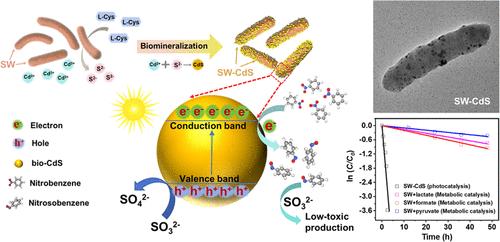当前位置:
X-MOL 学术
›
ACS Appl. Nano Mater.
›
论文详情
Our official English website, www.x-mol.net, welcomes your feedback! (Note: you will need to create a separate account there.)
CdS Nanoparticles-Decorated Shewanella oneidensis Cells for Ultrafast Photoreduction and Detoxification of Nitrobenzene
ACS Applied Nano Materials ( IF 5.3 ) Pub Date : 2024-06-15 , DOI: 10.1021/acsanm.4c01308 Yan-Zhai Wang 1 , Han Zhao 1 , Heng-Chi Liu 1 , Zhi-Zhi Yang 1 , Yang-Chun Yong 1, 2, 3
ACS Applied Nano Materials ( IF 5.3 ) Pub Date : 2024-06-15 , DOI: 10.1021/acsanm.4c01308 Yan-Zhai Wang 1 , Han Zhao 1 , Heng-Chi Liu 1 , Zhi-Zhi Yang 1 , Yang-Chun Yong 1, 2, 3
Affiliation

|
Nitrobenzene (NB) as essential products and raw materials in industrial production is a highly toxic and prevalent water pollutant that threatens human health and eco-safety. Photocatalytic methods are widely applied in the field of environmental remediation due to their unique photoexcited redox capacity, which provides a great potential for photoreduction of NB. Here, ultrafast photoreduction and detoxification of NB were explored by establishing a biohybrid photocatalytic system with mild biomineralization. It was discovered that the whole-cell hybrid system developed by biomineralization of CdS nanoparticles on the cell surface of Shewanella oneidensis MR-1 (SW) exhibited high photoreduction activity on NB. Strikingly, SW-CdS exhibited a first-order photoreduction rate constant (k) of 1.1 h–1, which was 54 times higher than that with S. oneidensis MR-1 (metabolic reduction). Impressively, this photoreduction rate achieved by SW-CdS was the highest photoreduction rate of NB ever reached by various nanoparticles. In addition, the photoreduction products obtained showed toxicity even lower than that of the traditional reduction product (aniline) for NB detoxification. Further analysis revealed that the biomineralized CdS nanoparticles served as the main catalytical center and contributed to the ultrahigh photoreduction efficiency of SW-CdS. This work provided a simple, ultrafast, and low-toxic method for the photoreduction and detoxification of NB, which would be promising for application in environmental remediation.
中文翻译:

CdS 纳米粒子修饰的 Shewanella oneidensis 细胞用于硝基苯的超快光还原和解毒
硝基苯(NB)作为工业生产的重要产品和原料,是一种剧毒且普遍存在的水污染物,威胁人类健康和生态安全。光催化方法因其独特的光激发氧化还原能力而广泛应用于环境修复领域,这为NB的光还原提供了巨大的潜力。在这里,通过建立具有轻度生物矿化的生物混合光催化系统,探索了NB的超快光还原和解毒。研究发现,Shewanella oneidensis MR-1(SW)细胞表面生物矿化CdS纳米粒子开发的全细胞混合系统对NB表现出高光还原活性。引人注目的是,SW-CdS 表现出 1.1 h –1 的一级光还原速率常数 (k),比 S. oneidensis MR-1(代谢还原)高 54 倍。令人印象深刻的是,SW-CdS 实现的这种光还原率是各种纳米粒子达到的 NB 的最高光还原率。此外,所获得的光还原产物的毒性甚至低于用于NB解毒的传统还原产物(苯胺)。进一步分析表明,生物矿化的CdS纳米粒子作为主要催化中心,有助于SW-CdS的超高光还原效率。这项工作为NB的光还原和解毒提供了一种简单、超快、低毒的方法,有望在环境修复中得到应用。
更新日期:2024-06-15
中文翻译:

CdS 纳米粒子修饰的 Shewanella oneidensis 细胞用于硝基苯的超快光还原和解毒
硝基苯(NB)作为工业生产的重要产品和原料,是一种剧毒且普遍存在的水污染物,威胁人类健康和生态安全。光催化方法因其独特的光激发氧化还原能力而广泛应用于环境修复领域,这为NB的光还原提供了巨大的潜力。在这里,通过建立具有轻度生物矿化的生物混合光催化系统,探索了NB的超快光还原和解毒。研究发现,Shewanella oneidensis MR-1(SW)细胞表面生物矿化CdS纳米粒子开发的全细胞混合系统对NB表现出高光还原活性。引人注目的是,SW-CdS 表现出 1.1 h –1 的一级光还原速率常数 (k),比 S. oneidensis MR-1(代谢还原)高 54 倍。令人印象深刻的是,SW-CdS 实现的这种光还原率是各种纳米粒子达到的 NB 的最高光还原率。此外,所获得的光还原产物的毒性甚至低于用于NB解毒的传统还原产物(苯胺)。进一步分析表明,生物矿化的CdS纳米粒子作为主要催化中心,有助于SW-CdS的超高光还原效率。这项工作为NB的光还原和解毒提供了一种简单、超快、低毒的方法,有望在环境修复中得到应用。









































 京公网安备 11010802027423号
京公网安备 11010802027423号